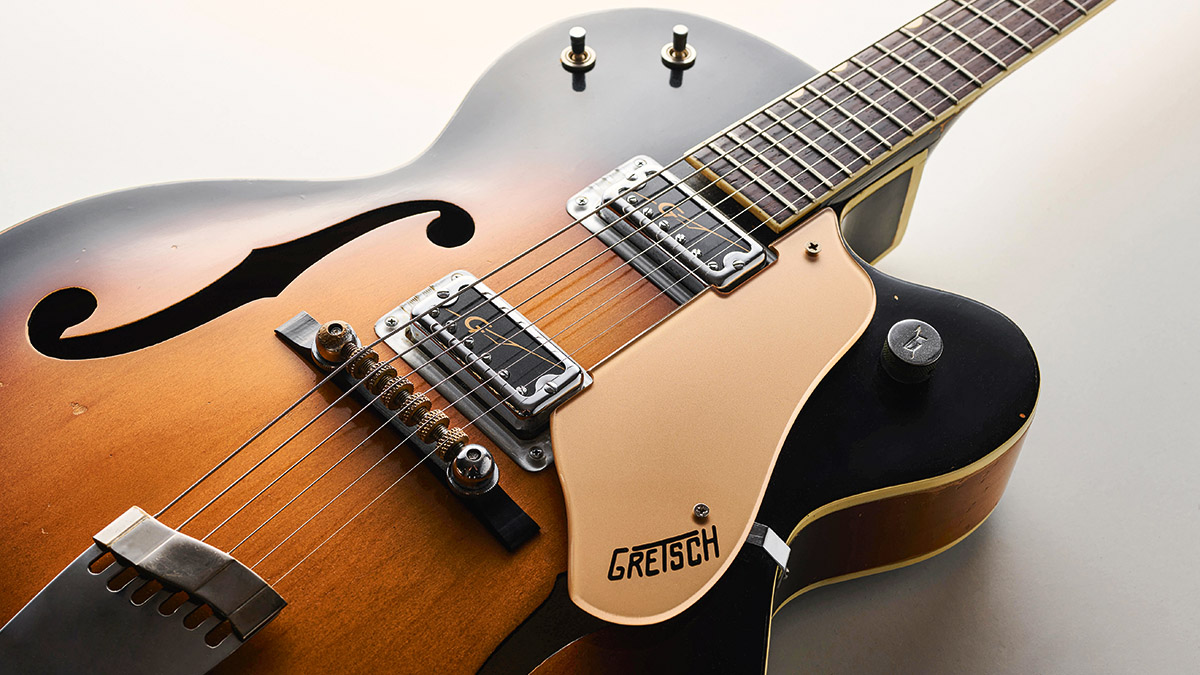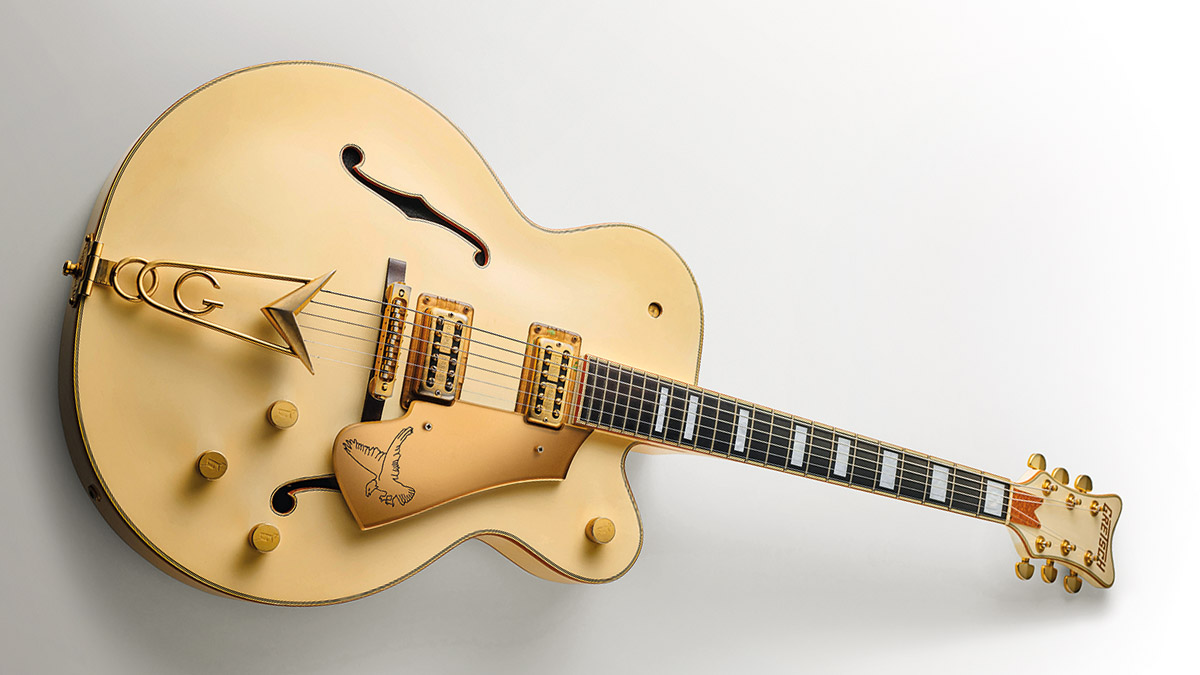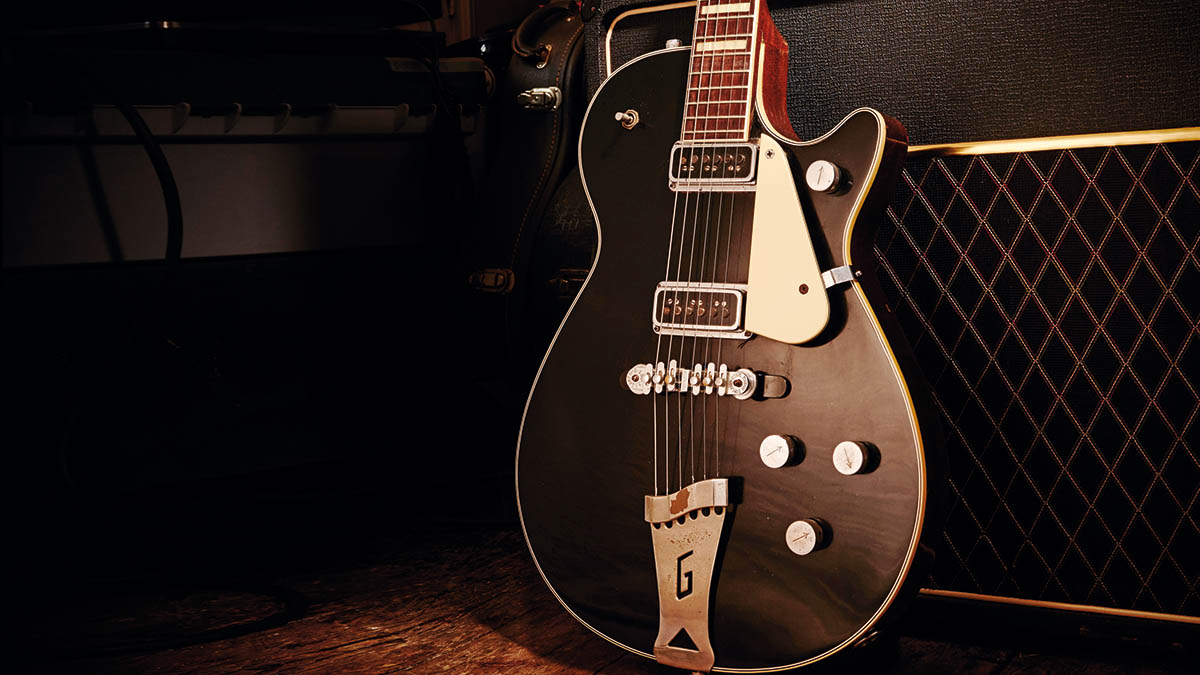
If the record-buying public had warmed to Jimmie Webster’s ‘Touch System’ two-handed tapping technique, then the Gretsch brand that we know today might never have existed.
Webster was an accomplished guitarist who played for Woody Herman and Count Basie during the 1930s, and who also tuned pianos when he wasn’t travelling the US and appearing on TV to demonstrate Gretsch guitars.
His role at Gretsch had similarities with Ted McCarthy’s at Gibson and Leo Fender’s at his namesake brand. He was pivotal in establishing the post-war Gretsch aesthetic and was a driving force behind Gretsch’s most iconic models. He also developed hardware, pickups and wiring harnesses.
Like his contemporaries, Webster observed trends in the automobile industry and the way car manufacturers maintained demand for older models by introducing new features and colours every year. With Fender revolutionising guitar design and rock ’n’ roll driving the market, Webster probably understood that Gretsch guitars were still essentially pre-war archtops and radical thinking was needed to stay in the game.
The 1950s and 60s were decades of change and innovation at Gretsch. Webster’s contributions range from the iconic and wildly successful to borderline bonkers, and we’ll be discussing them all throughout this feature as we take a deep dive into the technical development of Gretsch Guitars throughout the vintage era.
Electric Experiments
The first Gretsch Electromatic appeared back in 1939 and it featured a non-cutaway body with multi-coloured binding, a single ‘neck’ pickup and two Bakelite control knobs. These Electromatics were actually manufactured for Gretsch by Kay, and the quality doesn’t look that good.
Gretsch production was put on hold when the US joined World War II, and Gretsch players who wanted to go electric were more likely to retrofit aftermarket ‘floating’ pickups. The famous photo of Django Reinhart playing a Gretsch shows a blonde Synchromatic archtop, most likely fitted with a Leutone pickup.
Meanwhile, out in Ohio, a company called the Fox Sound Equipment Corporation had started making pickups for guitars. An accomplished local guitarist called Harry DeArmond had been taken on as a design consultant during the 1930s and the company’s name was soon changed to Rowe Industries.
DeArmond Dynasonic

Gretsch production was ramping back up by 1949, when the company introduced a new 6185 Electromatic model featuring a single pickup named after its inventor Harry DeArmond. The DeArmond Dynasonic or ‘Fidelatone’, as it was sometimes called, would remain Gretsch’s pickup of choice until 1958.
The Dynasonic had six individually adjustable magnets and typically read about 14kohms. But they were wound with relatively thin 44 AWG plain enamel wire, so they’re not as hot as that figure suggests. Gretsch also used celluloid shims to balance out bridge and neck pickups.
With its power, brightness and clarity, the Dynasonic is often associated with the greatest Gretsch tones of the vintage era. But Chet Atkins – who was Gretsch’s highest profile endorser – never liked them. He struggled with hum and found it difficult to achieve a balanced response. He also felt the strong magnets compromised sustain by exerting excessive pull on the strings.
Filter’Trons
Chet got to know Ray Butts when he bought one of his Echosonic amplifiers, and he had made Ray aware of the issues he was experiencing with Dynasonics. A while later, Ray showed Chet a prototype pickup loaded in his test guitar and asked him, “How would you like a pickup that doesn’t hum?”
According to Ray, that happened in 1954, and by September 1956 Chet was playing the Grand Ole Opry with a set of Ray’s humbuckers installed in his black 6120 prototype. Chet suggested to Gretsch that they should consider using Ray’s pickups.
Gretsch wasn’t pleased about Rowe Industries’ new production deal with Chuck Rubovits of Harmony Guitars, so it was agreed that Ray and Jimmie Webster would collaborate to develop a production version of Ray’s pickup. Gretsch would manufacture them in-house and in return Ray would receive royalties.
In 1957, the ‘Filter’Tron Electronic Guitar Head’ was launched at the same trade show as the Gibson PAF. The production version had small transparent nylon bobbins with space for the 42 AWG magnet wire. Vintage Filter’Trons typically read in the 4k to 5k range, so thicker Alnico V magnets were used to strengthen the magnetic field and increase inductance, which boosted midrange and output.
HiLo’Tron
Since the Filter’Tron was the only pickup the brand made, Gretsch fitted them to every guitar. Some customers must have been happy to forgo fretboard and f-hole binding when they were getting exactly the same tone at a far lower price.
Maybe that’s why Gretsch decided to create a new single-coil pickup that could be mounted directly onto the body. From mid-1960 onwards, lower-end models such as the Tennessean and Anniversary were reconfigured for this new pickup.
Lower in treble and output than a Filter’Tron, HiLo’Trons produce a warm, mellow and clear tone that is especially popular with players who are into 1960s tones
The HiLo’Tron wasn’t really half a Filter’Tron. Although they had the same bobbin, HiLo’Trons were wound with thinner wire and had smaller pole screws. With a bar magnet mounted on an angled steel plate and a vertical steel magnet keeper on one side of the magnet, the construction was quite different.
Bridge HiLo’Trons also had wood spacers to position them closer to the strings. Lower in treble and output than a Filter’Tron, HiLo’Trons produce a warm, mellow and clear tone that is especially popular with players who are into 1960s tones.
Super’Tron
Introduced in 1964, the Super’Tron was a variation on the Filter’Tron, with laminated blades, rather than adjustable pole screws. Aficionados praise its refined treble, high output and full-bodied tone. This pickup featured on various Gretsch models, including the Viking, Monkees, Roc Jet, Astro Jet and Streamliner.

Wiring
Dual-pickup Gretsches made prior to 1958 typically have a three-way pickup selector and four control knobs. There’s a volume for each pickup, plus a master volume located by the cutaway. The fourth knob served as a master tone and potentiometer values were 1 meg-ohm.
Between approximately 1955 and 1957 many Gretsches were fitted with unusual stacked tone potentiometers and two capacitors. Designed to be set about halfway for a ‘neutral’ tone, the control could roll off treble or bass, depending on which direction it was turned.
1958 saw the introduction of the infamous three-way ‘mud switch’ in place of a tone control. Bypassed in the middle position, the switch offered two levels of preset treble roll-off. It was a good idea badly executed
To coincide with the new Filter’Trons, 1958 saw the introduction of the infamous three-way ‘mud switch’ in place of a tone control. Bypassed in the middle position, the switch offered two levels of preset treble roll-off. It was a good idea badly executed due to unsuitable capacitor values.
Years later, Gretsch expert Tom ‘TV’ Jones talked Gretsch into replacing the vintage 0.1μF and 0.047μF capacitors with 0.012μF and 0.0039μF, and the mud switch finally emerged from the swamp.
The mud switch circuit featured 500k pots, but the way they’re wired in parallel with the master volume results in a 250k impedance. This possibly explains why the single-pickup/single-volume Anniversary model sounds brighter than the two-pickup version. Gretsch’s final innovation was an on/off switch that appeared around 1961.
Bodies & Bracing
Until the mid-50s, Gretsch’s big archtops were constructed in a conventional way. Most tops and backs were formed from pressed plywood and supported with parallel top bracing. As a friend and admirer of Les Paul, Chet Atkins was keenly aware of the design’s sustain shortcomings and lobbied hard for something closer to Les’s log concept.
A compromise was reached when Gretsch developed a ‘trestle bracing’ system and started fitting it in late 1957 to coincide with the introduction of Filter’Trons. The idea was to physically couple the top and back to make the body structure more rigid and stable.
The first version, which is known as the ‘heavy trestle’, involved parallel braces on the top and back, with the pine trestles glued along the length of the top braces between the neck block and the bridge. Legs protruded downwards at each end and were glued to the rear braces.
Finally, another block of pine was glued between the rearmost legs, spanning the area beneath the bridge. A ‘light trestle’ design followed in 1959, without the back braces and the bridge block. The trestles were joined to the back via small ‘feet’. Like Brian Setzer, most Gretsch players consider the light trestle to be the best sounding.
As the 1950s played out, single-cutaway Gretsch archtop bodies gradually became thinner
As the 1950s played out, single-cutaway Gretsch archtop bodies gradually became thinner. For instance, the 6120 model started out 2.75 inches deep and was 2.25 inches by 1961. Introduced in late 1957, the Country Gentleman had a wider 17-inch body with a two-inch depth.
The Country Gentleman also had fake f-holes, which was a return to Chet Atkin’s preferred specs when Gretsch built the first 6120 prototypes. Fake f-holes were later fitted to the HiLo’Tron Tennessean model and post-’61 6120s, as Gretsch started to introduce thinner double-cutaway bodies.

Responding to Gibson’s Les Paul, Gretsch introduced small ‘solidbody’ models in 1953. These included the Duo Jet and the top of the line Roundup, with the Jet Firebird following up in 1954. In reality, all were small-bodied archtops with heavily chambered mahogany bodies that became double-cutaways in 1961.
Gretsch’s first true solidbody was the Corvette of 1961. It started out like a cruder version of a double-cutaway Les Paul Junior or Special, but by 1963 the body edges had acquired SG-like sculpting.
With an all-mahogany set-neck construction, the model was available with one or two HiLo’Tron pickups. The Burns vibrato and bar bridge didn’t do it any favours, but if you drop in a P90 (like Rory Gallagher), a Filter’Tron or a mini-humbucker, they can sound amazing.
Neck Joints
Gretsch archtop necks were fitted using a traditional ‘dovetail’ joint, but they were not cut with the accuracy of manufacturers such as Gibson and Martin. Gretsch often relied on unusually thick wooden shims, and sometimes cardboard, to close the gaps. It’s fair to say that if a vintage Gretsch hasn’t had a neck reset, it probably needs one.
Prior to 1961, Gretsch drove a wood screw through the heel and into the neck block, and a circular plug was used to conceal the recessed screw head. This screw doesn’t actually strengthen the joint and may well have been deployed to hold necks steady while glue dried and to simplify the clamping.
Towards the later 1950s and early 60s, Gretsch began using a mortise and tenon joint. The inaccuracy and need for oversized shims remained, but the securing screw was shifted to either the cutaway side or the back of the body. So whenever a vintage Gretsch is undergoing a neck reset, the plug and screw must first be removed.
Finishes

For the most part, Gretsch guitars were sprayed with traditional nitrocellulose lacquer. However, it must be remembered that Gretsch also manufactured drums. Jimmie Webster realised that the ‘Nitron’ plastic wrap that Gretsch used for plywood shells could also be applied to guitar bodies using a vacuum press.
This finish can be seen on Duo Jets, Jet Firebirds and, most spectacularly, on the metallic Silver Jet and Champagne Sparkle Jet. The Nitron is so tough that it’s common to see vintage Gretsches with heavily worn backs and sides and tarnished hardware that retain pristine tops.
Bridges & Tailpieces
Gretsch was one of the first companies to offer a bridge with individually adjustable string intonation. Designed by Sebastiano (Johnny) Melita, the Synchro Sonic was made by Melita and first featured on the Electro II around 1951.
Soon after, Melita bridges were adopted for all premium Gretsch electrics, with carved rosewood preferred for lesser models. However, Bigsby-equipped guitars were paired with Bigsby’s compensated aluminium tailpiece.
Later in 1958, Webster’s Space Control bridge appeared, which was basically a threaded bar that was bent into a radius and fitted with six grooved thumbwheels. The idea was to allow players to adjust the thumbwheels to achieve their preferred string spacing. Gretsch also began fitting its own rudimentary but fine-sounding bar bridge by 1958. The shape and dimensions varied, but it was a bent and plated brass bar with milled string grooves.

With the exception of the earliest fixed Melitas, vintage Gretsch floating bridges tend to be a bit too buoyant. Any enthusiastic player can send them sliding, with predictable consequences for tuning. Thankfully, though, modern Gretsches have pins to keep them stable.
Throughout the 50s, most Gretsches had either a Bigsby or a G cutout tailpiece. The tailpiece came in two versions – six inches long for archtops such as the Anniversary, Streamliner and Clipper, and five inches for the various Jet models. The White Falcon and Penguin had a tubular ‘Cadillac’ tailpiece design.
Where Bigsby vibratos featured, Gretsch bought them from the manufacturer; B3s were fitted to smaller bodies and B6s to the bigger archtops. But in 1960, the bespoke B3C and B6C vibratos appeared with a ‘V’ cutout and ‘Gretsch By Bigsby’ on the front plate. Gretsch also used an inferior Burns vibrato on Corvette and various Jet models from 1962.
Webster’s Wonders
While Gibson had mostly pursued elegant craftsmanship, and Martin favoured an austere and near Shaker-like design aesthetic, guitar makers from Boston such as Stromberg, and New York’s D’Angelico and Gretsch were not averse to Jazz Age razzmatazz. Jimmie Webster’s more eye-catching efforts, like the Penguin, White Falcon and metallic green Country Club, came straight out of this tradition. Ditto the ‘country’ motifs that were first seen on the 1953 Roundup and would later appear on the 1956 6120.
These models are now regarded as iconic, but Webster innovations weren’t always so successful. One such item was the Tone Twister, which was intended as a vibrato for Gretsches without Bigsbys. Clamping across the strings in the gap between the bridge and tailpiece, the Tone Twister is known in Gretsch circles as the ‘String Snapper’.

As a piano tuner, Webster was aware that pianos are ‘stretch tuned’, with the upper registers a tad sharp to sound sweeter. He decided to apply this idea to guitar by angling the upper frets. The result was T-Zone Tempered Treble that featured on the Gretsch Viking. It didn’t catch on and Chet Atkins described the idea as “a little far-fetched”. Meanwhile, Gretsch was persisting with non‑intonatable bridges.
Access to the electronics, and Gretsch’s somewhat agricultural string muffling mechanism, was improved when the brand began cutting a huge hole in the back of the body. To conceal the ugly cover plate, Webster devised a pop on pad that looks like cheap upholstery and provides all the sensuousness of damp leatherette.
Webster’s ‘Floating Sound Unit’ was introduced in 1966. It involved a three-bar frame positioned in the bridge position, with a 440Hz tuning fork screwed onto the underside that passed through a hole into the body. The idea was to enhance sustain and harmonics, but if it isn’t carefully set up, the tuning fork generates wolf tones and it’s impossible to set intonation.

Maybe Webster was simply ahead of his time with his two-handed Touch System tapping technique. Such was his belief that he teamed up with Ray Butts to develop a stereo guitar and amplifier system specifically for his playing style.
This ‘Project‑O‑Sonic Stereo’ setup involved reconfigured Filter’Tron pickups that split the signals from the top three strings and the bottom three, and routed them to separate amplifiers. Gretsch models with Project-O-Sonic electronics included the White Falcon, Country Club and Anniversary, but it wasn’t a commercial success.
Maybe some of Webster’s inventions might have proved more successful if Gretsch had been able to provide the technical and engineering expertise to back him up. Even so, Webster’s contribution to Gretsch and his wider influence on guitar design cannot be denied and many of the models he helped to design are still being made today.







